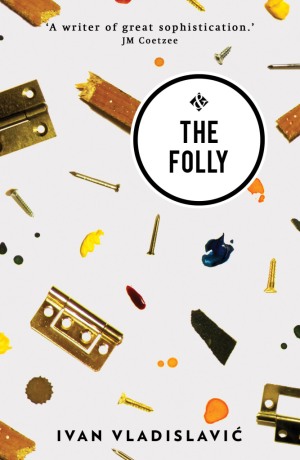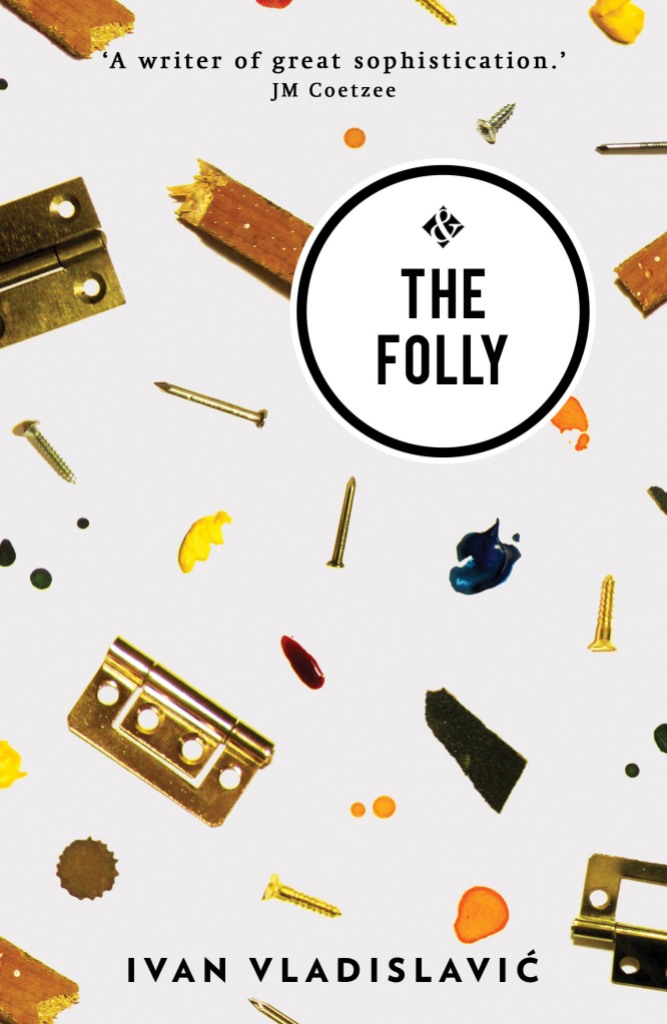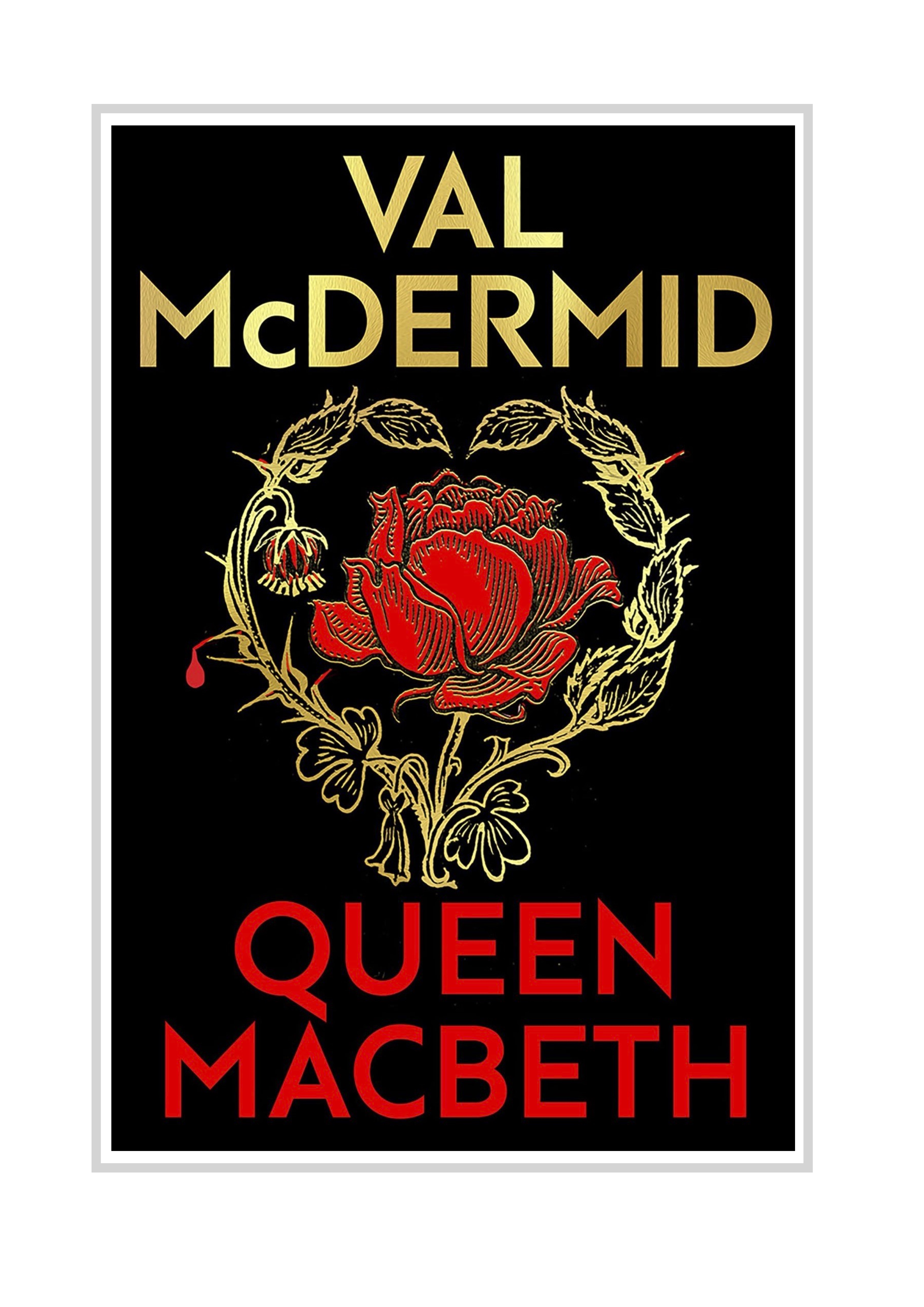Ivan Vladislavić, The Folly (And Other Stories, 2015)
By Lynnda Wardle
There are only two plots in all of literature: you go on a journey, or the stranger comes to town. (attributed to John Gardner (1984), The Art of Fiction: Notes on Craft for Young Writers)
One night an enigmatic stranger carrying a portmanteau arrives at an empty plot of land somewhere at the edge of a nameless city. The stranger, Nieuwenhuizen, sets about taming the land. He makes stuff out of old iron and rubbish lying around the disused plot, constructing a string grid that we find out later will form the masterplan for a new house he is going to build. Next door live Mr and Mrs Malgas (their name translates as “mad guest”). Mr and Mrs, as they are known, live a life of domestic drudgery: working in a hardware store (him), collecting kitsch bric-a-brac (her). Their uneventful life is to be completely transformed by the arrival of this new neighbour and Mrs, in particular, fears the noise and dust of a new building site and the threat of the invasion of insects. Mr, however, much more impressionable than his wife, is drawn into the outlandish wildness of Nieuwenhuizen’s dreams. His initial scepticism is put aside as he finally sees the Grand Plan for himself, the house “reveals” itself to him one night in a shimmering vision. He becomes Nieuwenhuizen’s most loyal and trusted sidekick, convinced that the building of this house will be an event that will go down in history as something monumental.
Malgas had never seen a more beautiful sight; his heart overflowed with wonder and gratitude. ‘We’ll have a garden too,’ he said to himself, surveying the barren soil, ‘with patios and grottos, red-hot pokers and bottle brushes, tennis-courts and hiking trails, an aviary and a fishpond with a wooden bridge for going over. But we’ll keep the camp just as it is, for the generations who come after us. We’ll declare it a monument, an open-air museum. We’ll never forget where we came from.
The Folly, initially published in 1993, is South African Ivan Vladislavić’s first novel and has been re-issued by And Other Stories in 2015. Since its first publication, he has written around 10 novels, a number of short story collections and has collaborated on book projects with various artists and photographers[1]. Arguably his most celebrated book, Portrait with Keys: the City of Johannesburg Unlocked (2006), is a sequence of documentary texts on Johannesburg. He is a Professor in the Creative Writing Department at Wits University in Johannesburg.
Published in the year before the democratic elections in South Africa, The Folly reflects the paranoia and unease characteristic of this time. It is both funny and cruel and casts a surreal look at the workings of power as the characters march across its pages like grotesque marionettes. We are not required to see these characters as “real.” Mr, Mrs and Father (as Nieuwenhuizen becomes to be called) are carriers of some deeper meaning which is not made explicit. Although one feels empathy for Mr (soft-hearted and easily fooled) or pity for Mrs (silly woman obsessed with her ornaments) or perhaps fondness for Nieuwenhuizen (a visionary, foolish Everyman, exploitative and tender at the same time), we are invited to reflect on them as figures trapped in an absurd existential situation rather than to relate to them as characters with whom we might “identify.”
The opening paragraph of the novel tells us that
Nieuwenhuizen stood on the verge, in the darkness, looking down the street.
In chapter 2, “Mr Malgas paused on the verge,” and in chapter 3, Mr Malgas and Nieuwenhuizen meet “on the verge.” As these two characters meet in untamed territory, a new construction for the new South Africa is being dreamed. In the beginning was the verge—the border between the Malgas land and the plot that Nieuwenhuizen has come to colonise takes on mythic significance. “Verge” suggests also that we are on the threshold of the new, and that anything may be possible. Like Mr, Mrs and Nieuwenhuizen, we can only imagine what this possibility may be like.
The Folly is an exploration of the power relations at the boundaries or verges between known and unknown and what happens when that volatile balance is disturbed. A “Folly” is defined by the OED as:
madness or delight, a favourite abode. A costly ornamental building (considered as) serving no practical purpose. Madness and rage.
Follies were whimsical structures popular in the 18th and 19th century, usually based on the ruins of earlier Greek, Roman or Egyptian palaces or temples, often constructed as an homage to the glories of former empires. Vladislavić’s interest in architecture and history will have informed this double-edged device. Vladislavić is a careful writer, his language sharp and specific in description. So Nieuwenhuizen’s new plot is:
bounded on two sides by an unruly hedge […] and on a third by a prefabricated cement wall with panels in the shape of wagon-wheels. The fourth side, where he found himself had once been fenced off from the street: the remains of this frontier – crumpled scrolls of barbed wire, a gate, some club footed wooden posts in concrete boots – lay all around. (My italics)
 These details given to us in the opening paragraphs of the novel describe the desolation of the outer frontier. Boundaries are of course the obsession of both coloniser and colonised, the location of tension, fear and war. They are the places where relationships of power are revealed. It is no accident that for many years under the apartheid government, the boundary between South Africa and the rest of Africa (for this read “Communist” Africa) was simply called “The Border”. Barbed wire and gates are part of the never-ending project of setting up and policing borders, of trying to keep something out (or in) depending on one’s status at the borderline. The wagon-wheels in the boundary wall should alert us to the old Afrikaner ideal of colonising and “civilising” the interior of Southern Africa (defending their laager against the enemy from behind the wheels of the Voortrekker wagons). Mr describes the new house as a “monument”, a reminder of another grand Folly, the Voortrekker Monument in Pretoria,[2] built in 1949 to commemorate the Great Trek, the journey undertaken by the Afrikaner settlers heading North to colonise the interior of Southern Africa. A huge granite structure, 40 feet high by 40 feet wide, with a Hall to Heroes and a frieze depicting historical battles, it is surrounded by a boundary, or a laager, constructed of 64 concrete Voortrekker wagons. It still stands as a symbol of the imperialist and missionary ideology of the early settlers.
These details given to us in the opening paragraphs of the novel describe the desolation of the outer frontier. Boundaries are of course the obsession of both coloniser and colonised, the location of tension, fear and war. They are the places where relationships of power are revealed. It is no accident that for many years under the apartheid government, the boundary between South Africa and the rest of Africa (for this read “Communist” Africa) was simply called “The Border”. Barbed wire and gates are part of the never-ending project of setting up and policing borders, of trying to keep something out (or in) depending on one’s status at the borderline. The wagon-wheels in the boundary wall should alert us to the old Afrikaner ideal of colonising and “civilising” the interior of Southern Africa (defending their laager against the enemy from behind the wheels of the Voortrekker wagons). Mr describes the new house as a “monument”, a reminder of another grand Folly, the Voortrekker Monument in Pretoria,[2] built in 1949 to commemorate the Great Trek, the journey undertaken by the Afrikaner settlers heading North to colonise the interior of Southern Africa. A huge granite structure, 40 feet high by 40 feet wide, with a Hall to Heroes and a frieze depicting historical battles, it is surrounded by a boundary, or a laager, constructed of 64 concrete Voortrekker wagons. It still stands as a symbol of the imperialist and missionary ideology of the early settlers.
Mr works at Mister Hardware; Nieuwenhuizen is building a new house (Niewenhuizen translates as “new house”) and they are destined as the perfect pair to work on this project together. Not just any house, as Mr points out to his doubting wife, but
He’s going to put up a mansion here, if I know him, magnificent place.
At no stage is there any real evidence of an actual structure. The grid is marked out by string and everything hinges on one carefully placed nail. As readers we are aware of the absurd nature of the project, the mapping of the grid with string and rusty nails, the Emperor’s clothes of a mansion with bathrooms and grand staircases. We are in no doubt of the gap between what the characters experience and what we understand to be their actual situation. This creates the ironic and comic slant of the novel – it is all folly, on so many levels. Just as we wait for Godot in Beckett’s eponymous drama, never truly believing he will arrive, in The Folly we are in a similar absurdist world, where external events impose themselves on the characters and their quests seem fruitless and without meaning.[3]
As their external world disintegrates around them, Mr and Mrs watch the violence on news every night. It is not difficult to see how Nieuwenhuizen might represent hope and salvation in this chaotic modern nightmare:
The box brought nothing but unrest and disorder, faction fights and massacres, even blood-baths, high pressure systems and cold fronts, situation comedies and real-life dramas, hijackings, coups, interviews with VIPs, royal weddings, exposés, scandals, scoops, conspicuous consumptions, white-collar crimes, blue-collar detergents, epidemics, economic indicators, peace talks, heart-warming instances of bravery and kindness to strangers, advertisements for dogfood and requests for donations. Each new atrocity struck Mrs like a blow, and she thrashed about in the La-Z-Boy like a political prisoner.
This novel has always been tricky to classify as one type of fiction or another. It has been variously called a fable or an allegory[4] and certainly it falls within the broader literary tradition of the absurd. In a country obsessed with classification by race or colour, one can see the appeal of writing a novel in 1993 that evaded easy classification. Stylistically there are ties to the 1960s surrealist experiments in Afrikaans literature, e.g. the short stories of Jan Rabie[5] or novels of Etienne Le Roux[6], and in English, J M Coetzee’s early novels In the Heart of the Country and Waiting for the Barbarians. Techniques of absurdist literature provide a way to describe political chaos obliquely. Even Vladislavić reflecting on the reissue of this novel is hesitant about nailing down the classification of the book too exactly:
At the same time, you could also say it’s also about the construction of the novel itself or the construction of an artwork — what goes into imagining something, but I think [I was] just playing with ideas and inventiveness and vision and a whole lot of different ideas that I must have had as a young artist. Like a slippery allegorical stature[sic], although not really an allegory, because you can’t match each element of the story onto something out there in the world, or find some conceptual consistency to it all. But it is open to a lot of different interpretations.[7]
The publisher’s blurb for this new edition suggests that this novel can be read as an allegory of the “rise and fall of apartheid” although I struggled to make that work over the length of the novel. To see this novel merely as a “parable” of apartheid is to fall into the same folly of perception that Mr and Mrs and Nieuwenhuizen suffer from. More accurately this is a satire on the unrealistic expectations of the new house, the utopian political mansion in which there will be a place for everyone. Nieuwenhuizen explains that
I left my home far away and came here to start over. It was a comfortable old place, to give it its due, with one and a half bathrooms, but it had served its time. It was falling apart, to tell the truth. Full of maggots and tripe. […] The earth around there was quite rotten, and soft, a bit like cheese.
But in fact the foundations of the “new house”, i.e. the economic inequalities and the power structures supported by these, remain intact. What is being constructed in the novel is both an artistic, architectural and political folly. In the nature of a modernist text such as this, multiple interpretations offer themselves up and The Folly is an exploration of the creation of a work of art as well as a cautionary tale about the follies of colonialism.
This novel is interesting in two respects; firstly, as the initial offering from a writer who will become an important voice in South African letters, The Folly can be seen as blueprint (grid?) for the author’s obsession with place. His later artistic concerns are mapped here in miniature: the acute awareness of the responsibility of the writer to treat language as a difficult medium; the relationship of writing to visual art and the built environment. This finds its mature expression in his 2006 work, Portrait with Keys, which gives full play to his flaneurial curiosity in a magnificent close reading of the streets of Johannesburg. Secondly, The Folly is a novel that is serious about reflecting on the conditions of its own production situated as it is at the troubled boundary between the old and new South Africa. The joy of reading this early gem by Vladislavić is that twenty years after the creation of the troublesome democratic South Africa, it still speaks to a nation struggling to raise the new out of the compromising ashes of the old. This “new house” that we have built – to what extent is this a folly? To what extent have we created an emperor strutting across a vacant plot, posing in fictional finery but naked and exposed, his flaws visible to all the world except himself?
Notes:
[1] http://ivanvladislavic.com/
[2] See photo at “Voortrekker Monument Laager” by Tim Giddings — Own work (Original text: self-made). Licensed under Public Domain via Commons
[3] Some of the characteristics of absurdist fiction can be seen at play here: “A well-made play is expected to present characters that are well-observed and convincingly motivated: these plays often contain hardly any recognizable human beings and present completely unmotivated actions. A well-made play is expected to entertain by the ding-dong of witty and logically built-up dialogue: in some of these plays dialogue seems to have degenerated into meaningless babble. A well-made play is expected to have a beginning, a middle, and a neatly tied-up ending: these plays often start at an arbitrary point and seem to end just as arbitrarily.” (From Martin Esslin (1961), The Theatre of the Absurd, New York, Doubleday).
[4] https://www.kirkusreviews.com/book-reviews/ivan-vladislavic/the-folly/
[5] http://www.humanrousseau.com/authors/912
[6] https://diesestigers.wordpress.com/etienne-leroux/
[7] http://www.leadershiponline.co.za/articles/ivan-vladislavic-11579.html





Leave a Reply